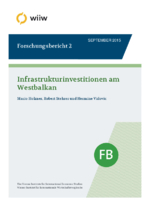Infrastrukturinvestitionen am Westbalkan
Mario Holzner, Robert Stehrer and Hermine Vidovic
wiiw Research Report in German language No. 2, September 2015
51 pages including 18 Tables and 31 Figures
Zusammenfassung
Infrastrukturinvestitionen am Westbalkan
Obgleich am Westbalkan in den letzten Jahren ein gewisser Aufholprozess bei der Errichtung von Verkehrsinfrastruktur zu verzeichnen war, bleibt die Eisenbahndichte gering und die Autobahndichte noch geringer. Auch der Nachholbedarf bei Energieinfrastruktur ist substantiell. Die aktuelle Initiative der „Core Network and Priority Projects“ im Rahmen des „Berlin-Prozesses“ sollte kurz- und mittelfristig Wachstum und Beschäftigung in der Region sichern und längerfristig zu einer wesentlichen Verbesserung der Wettbewerbsfähigkeit am Westbalkan beitragen. So konnte in der Analyse gezeigt werden, dass ein umfassendes Transportinfrastruktur-Investitionspaket von 7,7 Mrd. Euro über einen Zeitraum von 15 Jahren hinweg zu einem zusätzlichen Wachstumsschub von bis zu einem Prozentpunkt jährlich für die sechs Westbalkanländer führen könnte. Etwa 200.000 neue Arbeitsplätze könnten in der Region geschaffen werden.
English Summary
Infrastructure Investment in the Western Balkans
Although a certain amount of catching-up in the Western Balkans has been recorded in the construction of transport infrastructure in recent years, the railway density remains low and the motorway density is even lower. Also, the deficiency in energy infrastructure is substantial. The current initiative of the ‘Core Network and Priority Projects’ in the context of the ‘Berlin Process’ should secure growth and employment in the region over the short and medium term and contribute to a substantial improvement of competitiveness of the Western Balkans in the long term. It is shown in the analysis that a comprehensive transport infrastructure investment package of EUR 7.7 billion over a period of 15 years could lead to an additional growth spurt of up to one percentage point per annum for the six Western Balkan countries. Some 200,000 new jobs could be created in the region.
Reference to wiiw databases: wiiw Annual Database, wiiw FDI Database
Keywords: infrastructure, public investment, economic development, simulation model, Berlin Process, Western Balkans
JEL classification: E27, H54, O18
Countries covered: Albania, Bosnia and Herzegovina, Kosovo, North Macedonia, Montenegro, Serbia
Research Areas: Macroeconomic Analysis and Policy, Labour, Migration and Income Distribution, International Trade, Competitiveness and FDI
